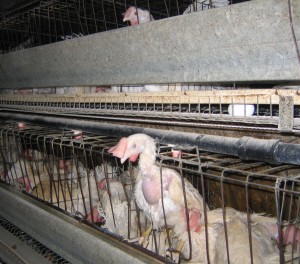
Pity the poor turkey. An inconceivable 20 million will be slaughtered in Canada in 2015, many of those destined to grace family Thanksgiving dinner tables.
Pity the turkey, the dairy cow, the chicken, the pig; in fact, pity all animals that are raised on factory farms to provide us with cheap meat and dairy products. They face horrific conditions on-farm. Turkeys and chickens genetically bred to grow quickly suffer from constant hunger, painful lameness and searing pain from hot-blade de-beaking and de-toeing. Dairy cows also endure painful lameness from lack of exercise, improper and dirty flooring, bad stall design and genetics – in fact, it’s estimated that 35 per cent of dairy cows in Canada are lame at any given time. Transport and slaughter provide no relief from the cruelty, as already compromised animals are subjected to rough handling, crowded transport and questionable slaughter methods.
The legal system provides little protection for farmed animals. The term ‘accepted management practices’ exempts conditions such as extreme confinement, often for the entire life-span of the animal, and painful procedures such as those mentioned above. Conditions on most farms are not monitored by government, or any other independent, third party.
Even when animals are subjected to cruelty that goes beyond that accepted as “necessary”, the law provides very little in the way of redress, even when convictions are achieved. In 2014, CBC’s Marketplace released graphic undercover footage obtained by Mercy for Animals Canada of a turkey breeder company in Ontario that supplies farms with up to 90 per cent of the turkey stock eaten in Canada. Workers were seen attempting to kill turkeys with broom handles and shovels, resulting in one bird being alive for more than five minutes after the bludgeoning began. Birds with open wounds and crippling injuries were left without adequate medical care.
The company and five of its employees were charged with eleven counts of animal cruelty. The company pled guilty to one count in exchange for the remaining ten being dropped. They were fined a mere $5,600.
Another case languishes in B.C. Undercover footage of Canada’s largest dairy farm in the Fraser Valley was released, again by Mercy for Animals Canada, in June, 2014. It exposed sickening abuse such as the repeated kicking and bludgeoning of dairy cows. In one case, a cow’s tail was viciously twisted until it broke. In a complaint to police, Dr. James Reynolds, a professor of large animal medicine at Western University, called it “the most severe case(s) of animal abuse I have ever seen in 32 years as a bovine veterinarian.” Even though the BC SPCA recommended to Crown Counsel that charges be laid against the company, Chilliwack Cattle Sales, and the employees involved, more than 15 months later, no charges have been laid and the public is left to wonder why nothing has happened.
Codes of Practice exist for all farmed animals in Canada. These codes have serious deficiencies, as they don’t address most issues of public concern, such as gestation crates for sows and battery cages for hens, as well as many painful procedures. The codes are not enforced and not enshrined in law in most provinces (although the Government of B.C. recently announced that the Code of Practice for the Handling of Dairy Cattle is being incorporated into the provincial Prevention of Cruelty to Animals Act) – rather, they provide minimum expectations for producers to follow. Unfortunately, there’s no way for the public to be assured that even these minimum guidelines are being followed because there is no third-party, arm’s length audit process. This means that on-farm cruelty must be addressed by complaints from the public – a near-impossible task since most farms are out of the way and are operated behind closed and locked barn doors.
Fortunately, the public’s concerns about the treatment of farmed animals are increasingly being heard by large companies such as McDonald’s, Wendy’s, Starbucks and others who are demanding accountability from their suppliers. Perhaps at some time in the future we will see all farmed animals treated with respect, dignity and empathy.
But in the meantime, pity the poor turkey and take time to contemplate that the product of such a cruel system has become a symbol for a family holiday of thankfulness. Perhaps consider extending your compassion to all animals by replacing them on your table with one of the delicious meat-free and cruelty-free alternatives so readily available, such as Tofurkey, Gardein Holiday Roast, “stuffed turk’y” and “turk’s cutlet”.

